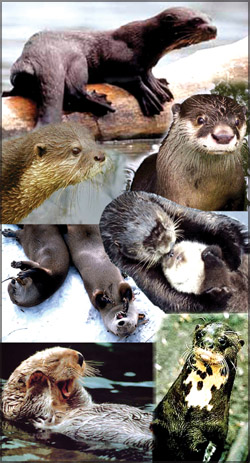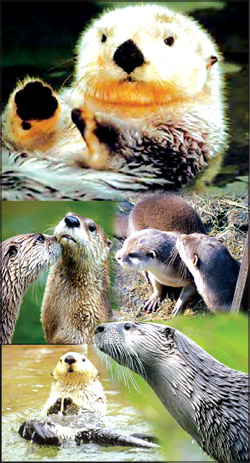Owners of luxurious fur coats!
 Do
you know which animal has the thickest fur coat in the entire animal
kingdom? Do
you know which animal has the thickest fur coat in the entire animal
kingdom?
The otter of course! Its luxurious fur coat, which could hold 250,000
to a million hairs per square inch, has proved to be a life saver as
well as a destroyer; this very thick fur coat, which insulates them from
the cold, has become the death of them with many hunting them just for
their fur coats!
Otters are the largest members of the Mustelidea family which
includes weasels, badgers, minks, polecats and skunks. They are
considered to be the smallest animals in the mammalian group with unique
traits. They are carnivorous.
are carnivorous.
There are 13 species of otters in seven genera.
Sea otters are one species while River otters are a sub- species and
are distributed almost worldwide.
Sea otters or Kalan as they are also known, are native to the North
Pacific. Historically they were found in the shallow waters of Japan,
the coast of Siberia, the Aleutian Chain, down the coast of Alaska,
British Colombia, Washington, Oregon, the Californian coast to Baja
California. But, due to a depletion in their population, they are now
mostly confined to California, Washington, Alaska, Canada, Russia and
Japan.
Unlike other marine mammals, otters have no layer of blubber (fat) to
keep them warm in the winter. So, how do they survive the cold winters
of the Pacific Ocean? They are naturally insulated by their two layered
fur coat. They have a soft undercoat and long, guard hair on top, with
air trapped between them to keep them warm. But, it isn't only the fur
coat that helps them keep warm.
Otters spend much of their lives in water hunting for food sometimes
for 5-6 hours per day, because they need to eat to build up fat in their
bodies. Nursing mothers hunt up to 8 hours per day.
They have high metabolic (chemical process producing energy and
growth)rates and burn up energy at a reckless pace. Sea otters must eat
about 20-25 per cent of their body weight per day, depending on the
water temperature, to survive while the Eurasian otters must eat at
least 15 per cent of their body weight.
Sea otters are the heaviest of the otters and the only species in the
genus Enhydra. They weigh about 45 lbs or more, with the Northern Sea
otters reaching up to 100 lbs.
They are about four feet long. The males have a life span of 10-15
years and the females 15-20 years.
A majority of pups are born in early spring and weigh about 3-5 lbs.
Generally, otter pups are born blind and helpless with fine grey fur
coats. Normally the female gives birth to one pup, but sometimes twins
are born though more often than not, one dies.
Otters are usually dusky brown, rather like milk chocolate in colour,
with paler coloured throats and belly patches. Sea otters may be
somewhat darker in colour.
 Otters
have small round heads, small eyes which are unique in that they could
see both in and out of water, short legs and slim, streamlined bodies
(especially built for life at sea where Sea otters are concerned). Most
species have sharp retractable claws, but all otters have webbed feet. Otters
have small round heads, small eyes which are unique in that they could
see both in and out of water, short legs and slim, streamlined bodies
(especially built for life at sea where Sea otters are concerned). Most
species have sharp retractable claws, but all otters have webbed feet.
As otters spend most of their time in the water, they have ears and
diamond-shaped noses with special valve-like skins that keep them
watertight when they dive after fish, their main food. They dive deep
into the water and can stay underwater for about two minutes.
They are also expert swimmers. However, pups cannot dive as their
coats trap a lot of air to keep them afloat when their mothers leave
them to hunt for food. Usually when otters rest in the water, they wrap
themselves in the kelp (sea weed) to prevent being drifted by the
currents. The mothers wrap the pups too in the kelp and with the aid of
the air trapped coats, they stay afloat, bobbing like corks in the
water.
Otter pups survive on their mother's milk until four weeks, and are
gradually weaned. They are taught survival skills by their mothers.
Until they are able to swim and move about on their own, the pups travel
on their mother's chests. The mothers 'coo' to the pups when they are
grooming them with their teeth or claws.
Otters are social creatures and usually live in groups called rafts.
Some live solitary lives. The females and pups live in one group and the
males form bachelor groups. The young can be seen grooming, diving,
swimming and playing in the water. The pups are totally independent by
12 months.
These warm-blooded animals have a unique system of eating and are in
fact the only mammals, other than primates, birds and others, to use
tools. The otters that thrive on fish (main diet) and also crayfish,
crabs, frogs and shellfish use rocks or other objects to pry open the
shellfish.
They sometimes use their stomachs as tables and rocks as tools to
break-open the shells. River otters which frequent lakes and larger
waterways travel overland from one body of water to another. But their
movement on land is rather awkward because their long, broadly flattened
and webbed hind-flippers have a fifth digit; it is very long, unlike in
other mammals.
Otters are threatened not only because they are hunted for their fur,
but also by the depletion(reduction) of their habitat, oil spills and
pollution of waterways.
****
Fact file
* Northern river otters are one of the most active, playful and
curious of all otter species. They were hunted and trapped for their fur
to near extinction in Northern America, along with the Sea otter.
* The Giant otter which was once freely found in the Amazon basin is
rarely seen today.
* The Sea otter is about 2.5-6 feet long with a weight of 65 lbs or
more, and the River otter is about 3-4 feet in length, weighting 10-30
lbs.
Otters eat 160 different types of food. They eat whatever they catch,
mostly at the surface. In waters of around 10 degrees Celsius, otters
need to eat a minimum of 100 grams of fish. They cannot survive if the
food intake is less.
* The collective noun for a group of otters is romp.
* River otters have been around for a long, long time. Fossils of
river otters that have been discovered date back from 100 BC to the
mid-1400s.
* Otters use their noses to communicate through scent. They also make
sounds; chirping, grunting, whistling and screaming.
The adults whistle or whine when upset, and hiss at predators.
They grunt when they are happy or enjoying a meal. Babies cry making
a shrill 'wee' sound like sea gulls, when left alone.
* Many otters, numbering between 3,500-5,000 have died as a result of
oil spills.
Eating marine animals covered in oil damages their eyes, liver, lungs
and kidneys.
* Underneath each powerful front paw is a pouch of skin which otters
use to store food collected during their dives underwater.
* Generally, otters stick to shallow coastal waters of no more than
55 metres deep.
* They are diurnal (daytime) animals and could be seen foraging and
grooming themselves most of the time. Feeding activity peaks in the
early morning.
* Otters consume more sea water than most other marine mammals.
* They rest in holes among river beds, tree roots and in kelp forests
in the water, often draping themselves with the kelp(large, brown
seaweed) to keep from drifting.
* Some of the otter species in the seven genera are: European otter,
Hairy-nosed otter, Speckle-throated otter, Long-tailed otter, Giant
otter, Sea otter and African clawless otter. |
